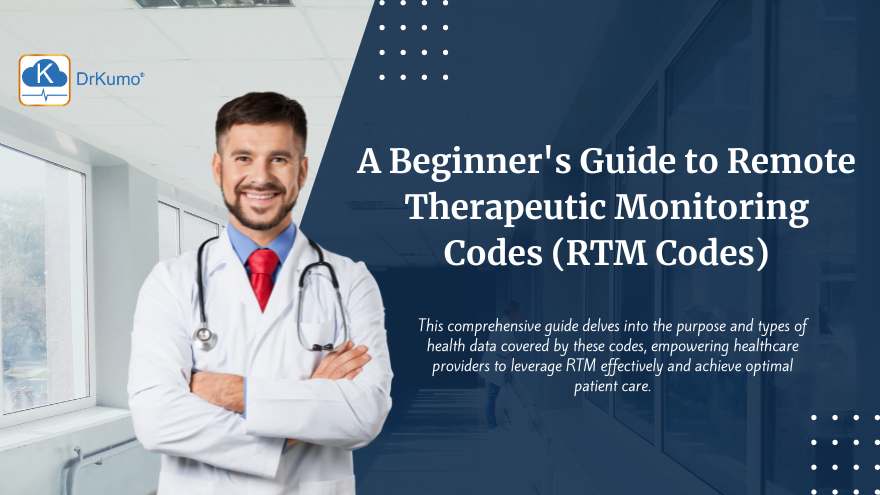Remote therapeutic monitoring has emerged as a powerful tool for healthcare providers, enabling them to track patient health data remotely and intervene proactively. This approach to patient care not only empowers early detection of potential issues but also fosters improved patient outcomes. By utilizing RTM codes, healthcare professionals can more effectively monitor and manage patient conditions, ensuring timely interventions and promoting better health management strategies. This technology plays a crucial role in optimizing remote patient monitoring systems, enhancing the efficiency and effectiveness of patient care.
However, ensuring proper reimbursement for these valuable services requires a solid understanding of Remote Therapeutic Monitoring codes (RTM codes), also known as RTM CPT codes.
This comprehensive guide delves into the purpose and types of health data covered by these codes, empowering healthcare providers to leverage RTM effectively and achieve optimal patient care.
What are RTM Codes?
RTM codes are specific billing codes within the Current Procedural Terminology (CPT®) codebook published by the American Medical Association (AMA). These codes categorize the various services rendered during remote therapeutic monitoring programs. Understanding and utilizing the appropriate RTM codes ensures accurate billing for the time and expertise invested in delivering RTM care.
Understanding RTM Codes: A Breakdown for Healthcare Providers
Understanding RTM CPT codes, is essential for healthcare providers who want to leverage RTM effectively and ensure proper reimbursement. These codes categorize the various services rendered during RTM programs. Here’s a breakdown of the key RTM CPT codes:
- Initial Setup and Patient Education (Codes 98975-98977): These codes cover activities like enrolling the patient, providing them with the necessary monitoring equipment, and ensuring they understand how to use it effectively.
- RTM Treatment Management Services (Codes 98980-98981): These codes are used to report the time a healthcare provider spends managing the RTM program for a patient. This includes reviewing transmitted patient data, identifying trends, communicating with the patient, and potentially adjusting treatment plans.
By understanding these codes and utilizing them correctly, healthcare providers can ensure accurate billing for the valuable services provided through RTM programs. This contributes to the financial sustainability of implementing RTM and allows providers to focus on delivering high-quality care to their patients.
The Purpose of RTM Codes
RTM codes serve several critical purposes for healthcare providers, such as:
- Accurate Reimbursement: Using the correct RTM code guarantees fair compensation for the services provided. This includes the initial setup and patient education, ongoing data monitoring and analysis, and communication with patients regarding their health status. Proper coding contributes to the financial sustainability of implementing RTM programs.
- Standardized Billing: RTM codes establish a standardized language for billing purposes across different healthcare settings. This consistency ensures transparency and simplifies billing processes for both providers and payers.
- Data Collection and Reporting: RTM codes play a role in data collection and reporting. By tracking the utilization of specific codes, healthcare organizations and regulatory bodies can gain valuable insights into the scope and impact of RTM programs.
Types of Health Data Covered by RTM Codes
The specific type of health data covered by RTM codes depends on the individual patient’s condition and the program’s goals. However, several broad categories are commonly monitored:
- Physiological Measurements: These can include blood pressure, heart rate, oxygen saturation, weight, and blood sugar levels. Regularly monitoring these indicators allows providers to identify trends and potential complications early on.
- Symptom Assessments: Patients may be equipped with tools to report symptoms electronically, such as pain scales, mood trackers, and medication adherence monitoring tools. This data provides valuable insights into a patient’s overall well-being and treatment effectiveness.
- Device Data: Many RTM programs utilize wearable devices that collect and transmit various health data points. RTM codes encompass the analysis and interpretation of this device-generated data.
Benefits of Utilizing RTM Codes
For healthcare providers, utilizing RTM codes offers a multitude of advantages:
- Improved Patient Care: By enabling closer monitoring of patient health data, RTM codes facilitate early detection and intervention for potential issues. This can lead to improved patient outcomes, reduced hospital readmission rates, and enhanced overall health management.
- Increased Patient Engagement: RTM programs inherently involve patients in their own care by providing them access to their health data. This fosters a sense of ownership and accountability, promoting better self-management of chronic conditions.
- Streamlined Workflow Efficiency: Utilizing user-friendly RTM platforms that integrate seamlessly with existing electronic health record (EHR) systems can streamline workflow processes for healthcare providers.
Challenges and Considerations
While RTM offers significant benefits, there are some challenges to consider:
- Coding Complexity: The RTM coding system can be intricate, with updates occurring periodically. Staying current on the latest guidelines from the Centers for Medicare & Medicaid Services (CMS) is essential to ensure accurate coding and avoid potential penalties.
- Technology Integration: Integrating RTM technology may require investments in new hardware and software, and staff training might be necessary to adapt to new workflows.
- Patient Selection: Identifying patients who can benefit most from RTM is crucial. Not all patients are suitable for remote monitoring, and some may require more in-person follow-up than RTM programs can provide.
Optimizing Your RTM Program
To leverage RTM effectively and unlock its full potential, healthcare providers can follow these best practices:
- Develop a Clear Strategy: Define the specific goals of your RTM program, such as improving chronic disease management or reducing hospital readmissions. Identify the target patient population and the types of conditions best suited for RTM.
- Invest in Staff Training: Equip your staff with the necessary knowledge and skills for RTM programs. This includes proper coding procedures, patient selection criteria, data security protocols, and effective communication techniques for remote patient interaction.
- Choose User-Friendly Technology: Select an RTM platform that integrates seamlessly with existing EHR systems and is user-friendly for both patients and providers. Prioritize platforms with intuitive interfaces and clear instructions for patients using the monitoring equipment.
Through understanding RTM codes,healthcare providers can unlock the transformative potential of remote therapeutic monitoring. This knowledge empowers them to:
- Deliver Value-Based Care: RTM aligns perfectly with the growing emphasis on value-based care models. By proactively managing chronic conditions and preventing complications, RTM programs can contribute to improved patient outcomes and reduced healthcare costs.
- Expand Patient Access: RTM allows for the delivery of care to patients in remote locations or those with limited mobility. This expands access to high-quality care and promotes greater healthcare equity.
- Strengthen Patient-Provider Relationships: Regular communication and data sharing fostered by RTM programs can strengthen the bond between patients and providers. This collaborative approach to care can lead to better treatment adherence and improved patient satisfaction.
The Future of RTM Codes
The future of RTM codes is promising as technology and healthcare practices continue to evolve. Here are some potential trends to consider:
- Simplified Coding Structure: Efforts towards streamlining the RTM coding structure are ongoing, aiming to make it more user-friendly and reduce the risk of coding errors.
- Integration with Artificial Intelligence (AI): The integration of AI into RTM platforms can unlock new possibilities for data analysis and real-time feedback. This could lead to more personalized treatment plans and improved patient outcomes.
- Standardized Data Exchange: The development of standardized data exchange formats will facilitate seamless communication between RTM platforms and EHR systems. This will improve data accessibility and optimize workflow efficiency.
Partnering with DrKumo to Optimize Your RTM Program
While understanding RTM codes is crucial, navigating the complexities of implementing and managing an RTM program can be challenging. DrKumo, a leader in Digital Health for Chronic Care, offers a comprehensive RTM solution designed to empower healthcare providers like you to seamlessly integrate RTM into your practice and unlock its full potential.
DrKumo’s user-friendly platform goes beyond just facilitating data collection. Their secure platform ensures HIPAA compliance and provides real-time data streaming, allowing you to closely monitor vital signs and intervene promptly when necessary. Additionally, DrKumo offers a variety of features to streamline your workflow, including:
- Multicast Data Live-Streaming: Enables efficient remote patient monitoring and reduces the risk of cross-infection.
- State-of-the-Art Hardware and Software: Provides patients with user-friendly devices and a secure platform for data transmission.
- Integration with Existing EHR Systems: Simplifies data management and workflow efficiency.
- Telehealth Support Services: Offers additional options for remote patient interaction.
By partnering with DrKumo, you can:
- Simplify RTM Program Implementation: DrKumo’s team of experts can guide you through the process, ensuring a smooth transition to RTM.
- Enhance Patient Engagement: DrKumo’s user-friendly platform empowers patients to actively participate in their care.
- Improve Patient Outcomes: Real-time data access and timely interventions contribute to better patient health management.
- Optimize Reimbursement: DrKumo’s platform facilitates proper coding and billing practices for RTM services.
Takeaways
Through understanding RTM codes and implementing best practices, healthcare providers can position themselves at the forefront of remote therapeutic monitoring. This innovative approach to patient care empowers closer monitoring, proactive interventions, and ultimately, improved health outcomes for patients. As technology continues to advance and RTM codes evolve, healthcare providers who embrace RTM stand to unlock a future of value-based, accessible, and patient-centered care.
Ready to revolutionize your chronic care management with DrKumo’s innovative RTM solutions? Contact DrKumo today to learn more and schedule a free consultation!









